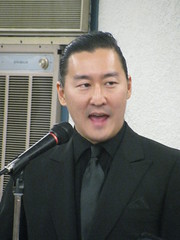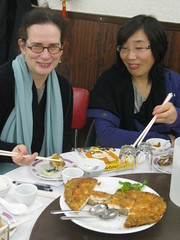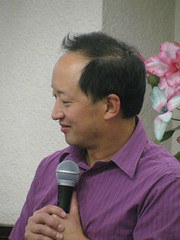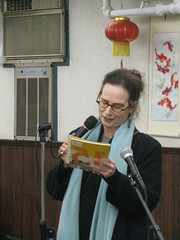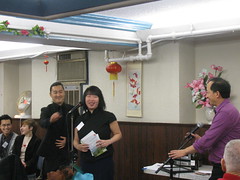Hapa-Palooza poets helps celebrate Vancouver 125
The largest meeting room at the downtown Vancouver Public Library was full. Anna Kaye Ling was moderating questions from the audience to poets Fred Wah, Joanne Arnott and Tanya Evanson. Ling is one of the co-founders of the brand new Hapa-Palooza Festival, and is also a director for Asian Canadian Writers' Workshop – the sponsoring organization, that helped submit the grants to Vancouver 125.
Each of the poets grew up from mixed race ethnic backgrounds. Wah is Swedish/Chinese/Scottish/Irish, Evanson is Black/Mixed Caucasian and Arnott is Metis/Mixed. I've known Fred Wah since 2003, when Asian Canadian Writers' Workshop presented him with the ACWW Community Builder Award. A few years later, I invited Wah to be the featured poet at the 2005 Gung Haggis Fat Choy Robbie Burns Chinese New Year Dinner.
It would be simple if as the last person from the audience to ask a question, suggest that we forego all labels of race or ethnicity and simply “recognize each other as human beings.” But poetry and experience that addresses growing up mixed-race isn't that simple. Humankind has always created a sense of “otherness” to shun those “not like us.” Wah's award winning poetry books “Diamond Grill” and “is a door” both address the joys and pitfalls of “looking different”.
While the topic of racism, and not fitting in on both your mother's side, and your father's side, was upsetting to some members of the audience, there was a larger sense that this was community. It was a community of recognition. It was a community of meeting other people like themselves. It was a community that was saying “our time has come,” as Canada's first Festival celebrating Mixed Ancestry kicked off it's first of 4 days.
Hapa is a Hawaiian term meaning Half. It is historically used to describe somebody as hapa haole (half white), but recently it has been used to describe somebody who is half Asian or Pacific Islander. But now it being used to describe a new emerging tribe of Hapa-Canadians, and their culture – similar to the use of the word Metis. Historically, Metis was used to describe anybody of First Nations and European heritage. These people were not fully accepted in either culture, and thus created their own. And today Hapa is doing the same.
I looked around the room, and saw many Hapa Canadians that I knew, didn't know, and some who were my friends. Rema Tavares, founder of www.mixed-me.ca had flown out from Toronto to excitedly attend this festival. Brandy Lien Worrall was holding her new 4 month old Hapa baby, born of Hapa-Vietnamese-Chinese-Pensylanvian Duth, and Hapa-Filipino parents. Ricepaper Magazine (published by ACWW) was there with our managing editor Patricia Lim, and intern Cara Kuhane – who is a Hawaiian born Hapa.
And I saw my cousin Tracey. We are both descended from Rev, Chan Yu Tan, our great-great-grandfather who came to Canada in 1896. Her father is Anglo-Canadian. When she graduated from high school, as a present, I took her to see the play Mixie and the Half-Breeds, written by my Hapa friends Adrienne Wong and Julie Tamiko Manning. Tracey enjoyed it tremendously, as it addressed issues of mixed race identity. Afterwards we went out to eat with Julie and Adrienne. It was one of the first times Tracey got to meet Hapa artists who actively developing Hapa culture! Tonight, my little cousin Tracey, is in 3rd year university, and embracing her Hapa-ness by volunteering as a photographer for the festival.
I introduced Tracey to poet Fred Wah, then in the audience we said hello to poets Roy Miki and Daphne Marlatt. I introduced her to the co-founders of the Hapa-Palooza, my Hapa friends Jeff Chiba Stearns, Zarah Martz and Anna Kaye Ling. This is my community, which recognized and embraced her as Hapa. They commented how wonderful it was that Gung Haggis Fat Choy was one of the inspirations for Hapa-Palooza, and how my Hapa cousin was possibly one of the inspirations for me creating Gung Haggis Fat Choy, as I had wanted to create an event that was inclusive for my family members who were Scottish and Chinese and Hapa.
If more families had members who were of diverse ethnic ancestry, and had more Hapa children – then hopefully there would be less racism. Because if everybody is related and inclusive to every other race, then it would be harder for politicians to pass laws and legislation such as the Chinese head tax, the Chinese Exclusion Act, the Potlatch Law, the internment of Japanese Canadians, and excluding First Nations from voting until 1960… as Canada did in the 19th and 20th Centuries – because you're gonna hear it from your in-laws!






 “Banana’s here! Poor thing. Illiterate and can’t speak properly.”
“Banana’s here! Poor thing. Illiterate and can’t speak properly.”





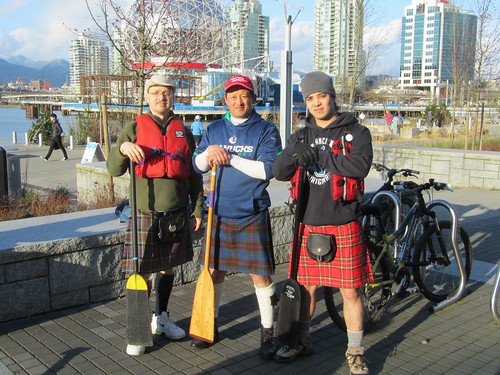 -photo courtesy of T.Wong
-photo courtesy of T.Wong
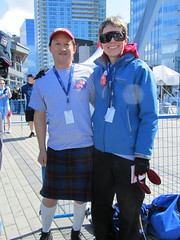 – photo Deb Martin
– photo Deb Martin



